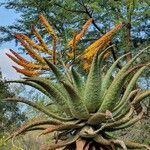Trees 2-4(-10) m tall; stems simple. Leaves 40-50, arcuate-incurved to spreading or slightly recurved with age, 750-1500 x 75-250 mm, channelled to D-shaped in section, glaucous, usually with irregular prickles on both surfaces, these normally fewer on upper surface. Inflorescence of spreading to rarely erect, usually secund, rarely cylindric racemes, with up to 30 branches; bracts ovate-acute, 4-9 x 2-5 mm, 3-5-nerved. Flowers yellow to red in bud, yellow to orange at flowering, cylindric to ventricose, 22-35 mm long; outer segments connate for one third to half their length, inner segments adnate to outer in basal third; pedicles 3-5 mm long. Anthers exserted 8-20 mm. Ovary 5.0-9.0 x 1.5-5.0 mm, green; style exserted 6-20 mm. Fruit 19-21 x 10-12 mm, grey.
A succulent plant. It can grow to 4-6 m tall. It has a stout un-branched stem. The old leaves hang on the stem. The leaves are fleshy and form a dense rosette. They are grey green. There is a channel on the upper surface of the leaves. There are reddish brown spines on both surfaces of the leaves. There are teeth along the edges. The flower stalk has many branches. The strings of flowers are at an angle to the stalk. The flowers occur on the upper side of these horizontal stalks. The flowers are like a cylinder and are yellow or orange. The flowers are rich in nectar.
Leaves in a dense rosette at the stem apex, spreading-erect to somewhat incurved; lamina to 1–1.5 m long, 20–25 cm wide at the base, lanceolate-attenuate, deeply channelled, dull greyish-green, often tinged reddish, without spots, both surfaces but especially the lower surface with scattered reddish-brown prickles 3–4 mm long, or both surfaces smooth; margin with pungent deltoid reddish-brown teeth 3–6 mm long and 10–20 mm apart.
Inflorescence erect to c. 80 cm tall above the leaf rosette; peduncle stout, 10-branched or more, the lower branches rebranched; branches spreading horizontally, subtended by brown scarious bracts c. 2 × 15 mm, with scattered sterile bracts below each raceme.
Perianth golden-yellow to orange or reddish-orange, 25–35 mm long, c. 7 mm in diameter across the ovary, enlarging to c. 11 mm at the middle then narrowing toward the mouth, cylindrical-ellipsoid; outer segments free for c. two-thirds, with tips spreading.
Racemes 30 or more, 15–50 × 5.5 cm, ± horizontal, densely flowered with the flowers secund along the upper edge of the rhachis; bracts 4–7 × c. 5 mm, ovate-acute, scarious, pale brown; pedicels 5–8 mm long.
Small tree 2–4(6) m high, usually solitary or sometimes suckering to form small groups of plants, stem simple, erect or decumbent, 1–3 m long, clothed in withered leaf remains.
Stamens and stigma exserted 10–15 mm; stamens with filaments blackish-purple, anthers orange, stigma brown.
Capsule and seeds not seen.


